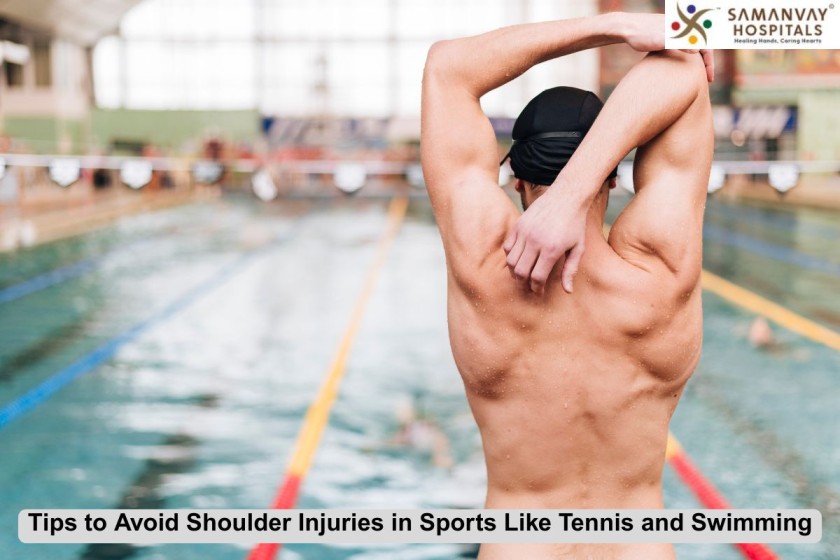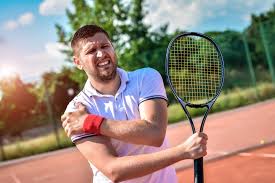
Table of Contents
Introduction
Shoulder injuries are found in sports such as swimming and tennis. Both sports include huge ranges of movement of the shoulder and arm. You are bound to get hurt if you are not careful. Injuries will prevent you from playing and result in long-term pain. Therefore, it is important that you know how to prevent shoulder injuries.
This article will suggest a few easy tips on how to protect your shoulder. Regardless of whether you play tennis frequently or swim, these tips will make you injury-free. However, you will also know when to see a doctor in case of injury. Good treatment of shoulder injuries is provided by some of the best hospitals of Baroda and the best hospitals in Gujarat India. Good care of your shoulders will make you enjoy your sport.
Why are shoulder injuries common in tennis and swimming?
Both tennis and swimming involve repeated shoulder movement. This produces muscle strain in the tendons and joints of the shoulders. An extremely flexible joint is the shoulder. However, flexibility carries an injury predisposition with it.
Common reasons for shoulder injuries in these sports:
- Repetition of overhead motion causes muscle strain.
- Poor technique places additional stress on the joint.
- Less powerful muscles do not support the shoulder.
- Proper warm-up reduces the chances of injury.
- Fatigue occurs due to overtraining or insufficient rest.
Moreover, knowing why injury occurs will help you prevent it better. For example, most shoulder pain patients presenting at Gujarat, India, hospitals have poor warm-ups and overuse. You must not make these errors.
Understanding shoulder anatomy and injury types
The bones, muscles, tendons, and ligaments make up the shoulder joint. The joint is very flexible at the expense of vulnerability. Some of the most common tennis and swimming shoulder injuries include:

- Rotator cuff tears: Rotator cuff tears are ruptures of muscles that assist in lifting and rotating the arm.
- Tendonitis: Tendonitis from repetitive or overuse of tendons.
- Shoulder impingement: Compression of tendons during lifting of the arm.
- Dislocation: Shoulder joint dislocation.
- Labral tears: Rupture of the cartilage in the lining of the shoulder joint.
Early knowledge of such injuries will be early symptom detection. Additionally, early intervention will avoid severe damage.
Warm-up and stretching techniques
Pre-warming before playing or swimming is required. Warm muscle is elastic and better able to withstand damage. The following is a successful warm-up routine:
- Begin with 5-10 minutes of light cardio (jogging or cycling).
- Do shoulder circles: Move shoulders in slow circles forward and backward.
- Arm swings: Cross arms over back and body slowly.
- Shoulder stretches: Slowly pull the front and back of the shoulder to stretch.
- Hold the stretch for 15-30 seconds. Never bounce when stretching.
Shoulder stretch example:
- Cross-body shoulder stretch
- Doorway chest stretch
- Triceps stretch
These will get blood flowing and relax the muscles. Most athletes skip this, and then they become injured. So, always warm up.
Proper technique and form in tennis and swimming
Proper form should be employed so as not to injure the shoulder. Poor form bends and injures the shoulder.
Tennis Tips:
- Use the whole body, and not just the arm, with shots and serves.
- Do not “overreach” on shots; keep shoulders relaxed.
- Spin into smooth, controlled movement instead of a stiff, jerky stroke.
- Keep a strong but not stiff wrist.
Swimming Tips:
- Use even strokes, with no freestyle, backstroke, or butterfly.
- Don’t hold arms too far across the midline.
- Keep elbow over hand on freestyle strokes.
- Breathe side to side in order to be centered.
Trainers at Baroda’s top hospitals will emphasize that technique would avoid injury.
Strengthening exercises for shoulder stability
Strong muscles protect your shoulder from injury. Emphasize strengthening exercises for rotator cuff and shoulder stabilizers.
Easy Strengthening Exercises:
- External rotations: Hold a light resistance band. Place elbow at side, rotate arm outward.
- Internal rotations: Rotating the arm inward using the same band.
- Scapular squeezes: Squeeze shoulder blades together and hold for 5 seconds.
- Shoulder presses: Press up slowly using light weights.
- Wall push-ups: Strengthens shoulder stabilizers safely.
Do the exercises 2-3 times a week. Begin with light weights. Progress slowly and avoid strain.
Rest and recovery: avoiding overuse
Overuse injuries are when the shoulder does not get time to rest. Tennis players and swimmers are well known for working every day, which exposes them to increased risk.
Rest tips:
- Have frequent breaks between training sessions.
- Plan rest days once a week to recharge.
- Sleep well to enable muscles to recover.
- Apply ice packs following strenuous exercise to minimize inflammation.
- Listen to your body—stop if you experience pain.
Skipping rest may result in chronic injuries that require treatment in Gujarat, India, hospitals.
When to seek medical help?
Occasionally shoulder pain requires a physician. You must be seen by a doctor if:
- Pain persists longer than one week.
- There is swelling or bruising.
- The shoulder is unstable or weak.
- You are unable to move your arm at all.
- Pain increases with use or rest.
Early diagnosis avoids long-term damage. The best Baroda hospitals have experienced orthopedic physicians. They provide tests such as MRI or X-ray to detect causes of damage. Early therapy may involve physical therapy, medication, or surgery if necessary.
Preventive measures at home and training
Prevention is better than a cure. Exercise and rest aside, utilize these recommendations:
- Wear appropriate equipment such as tennis rackets and swimming equipment.
- Modify the size of your racket and string tension to reduce shoulder strain.
- Maintain good posture on and off the court.
- Stay hydrated and eat healthy nutrition for muscle well-being.
- Cross-train in other sports to level out muscle usage.
- Performing these reduces the risk of shoulder injury significantly.
Conclusion
Tennis massage and swimming shoulder injuries are common but avoidable. Warm-up, strength training, and correct technique are needed. Therefore, avoid overuse with rest and recovery. Early medical treatment ensures long-term health. Numerous patients experience benefits at the best hospitals in Baroda and Gujarat, India. Beware of your shoulders to engage in sport pain-free for years.
FAQs
1: How often do I train shoulder strength?
Do them 2-3 times a week for maximum effect.
2: Is weak swimming technique the cause of shoulder injury?
Yes, poor strokes put pressure on the shoulder and raise the risk of injury.
3: What is the initial warning sign of a shoulder injury?
Repetitive pain on or after exercise is an early warning sign.
4: Do I ice my shoulder after tennis?
Yes, ice does help minimize swelling and recovery.







